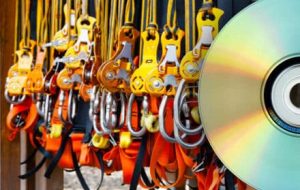Steel Erection
OSHA Training Requirements - STEEL ERECTION
This website is not the official or final authority to determine OSHA compliance responsibilities, which are set forth in OSHA standards themselves, and the Occupational Safety and Health Act of 1970. Because OSHA regulations are constantly being added, deleted, and/or revised, you must not rely on this website as the official or final authority of OSHA training requirements; refer to the official OSHA regulations available on OSHA’s website (osha.gov). – See disclaimers.
1926.750 – 1926.761 – Steel Erection
1926.751 – Definitions
Competent person (also defined in § 1926.32) means one who is capable of identifying existing and predictable hazards in the surroundings or working conditions which are unsanitary, hazardous, or dangerous to employees, and who has authorization to take prompt corrective measures to eliminate them.
Qualified person (also defined in § 1926.32) means one who, by possession of a recognized degree, certificate, or professional standing, or who by extensive knowledge, training, and experience, has successfully demonstrated the ability to solve or resolve problems relating to the subject matter, the work, or the project.
1926.752 – Site Layout, Site-specific Erection Plan and Construction Sequence
(e) – Site-specific erection plan. Where employers elect, due to conditions specific to the site, to develop alternate means and methods that provide employee protection in accordance with § 1926.753(c)(5), § 1926.757(a)(4) or § 1926.757(e)(4), a site-specific erection plan shall be developed by a qualified person and be available at the work site. Guidelines for establishing a site-specific erection plan are contained in Appendix A to this subpart.
1926.753 – Hoisting and Rigging
(c)(1) – Pre-shift visual inspection of cranes.
(i) – Cranes being used in steel erection activities shall be visually inspected prior to each shift by a competent person; the inspection shall include observation for deficiencies during operation. At a minimum this inspection shall include the following:
(ii) – If any deficiency is identified, an immediate determination shall be made by the competent person as to whether the deficiency constitutes a hazard.
(c)(2) – A qualified rigger (a rigger who is also a qualified person) shall inspect the rigging prior to each shift in accordance with § 1926.251.
(c)(5) – Safety latches on hooks shall not be deactivated or made inoperable except:
(i) – When a qualified rigger has determined that the hoisting and placing of purlins and single joists can be performed more safely by doing so . . . ;
(d)(2) – When working under suspended loads, the following criteria shall be met:
(iii) – All loads shall be rigged by a qualified rigger.
(e) – Multiple Lift Rigging Procedure
(1) – A multiple lift shall only be performed if the following criteria are met:
(i) – A multiple lift rigging assembly is used;
(ii) – A maximum of five members are hoisted per lift;
(iii) – Only beams and similar structural members are lifted; and
(iv) – All employees engaged in the multiple lift have been trained in these procedures in accordance with § 1926.761(c)(1).
(2) – Components of the multiple lift rigging assembly shall be specifically designed and assembled with a maximum capacity for total assembly and for each individual attachment point. This capacity, certified by the manufacturer or a qualified rigger, shall be based on the manufacturer’s specifications with a 5 to 1 safety factor for all components.
1926.754 – Structural Steel Assembly
(d)(1) – When deemed necessary by a competent person, plumbing-up equipment shall be installed in conjunction with the steel erection process to ensure the stability of the structure.
1926.755 – Column Anchorage.
(a) – General requirements for erection stability.
(4) – All columns shall be evaluated by a competent person to determine whether guying or bracing is needed; if guying or bracing is needed, it shall be installed.
(b) – Repair, replacement or field modification of anchor rods (anchor bolts).
(1) – Anchor rods (anchor bolts) shall not be repaired, replaced or field-modified without the approval of the project structural engineer of record.
(2) – Prior to the erection of a column, the controlling contractor shall provide written notification to the steel erector if there has been any repair, replacement or modification of the anchor rods (anchor bolts) of that column.
1926.756 – Beams and Columns
(a) – General
(1) – During the final placing of solid web structural members, the load shall not be released from the hoisting line until the members are secured with at least two bolts per connection, of the same size and strength as shown in the erection drawings, drawn up wrench-tight or the equivalent as specified by the project structural engineer of record, except as specified in paragraph (b) of this section.
(2) – A competent person shall determine if more than two bolts are necessary to ensure the stability of cantilevered members; if additional bolts are needed, they shall be installed.
(b) – Diagonal bracing. Solid web structural members used as diagonal bracing shall be secured by at least one bolt per connection drawn up wrench-tight or the equivalent as specified by the project structural engineer of record.
1926.757 – Open Web Steel Joists
(a) – General
(2) – Where constructibility does not allow a steel joist to be installed at the column:
(i) – an alternate means of stabilizing joists shall be installed on both sides near the column and shall:
(B) – be designed by a qualified person;
(4) – Where steel joists at or near columns span more than 60 feet (18.3 m), the joists shall be set in tandem with all bridging installed unless an alternative method of erection, which provides equivalent stability to the steel joist, is designed by a qualified person and is included in the site-specific erection plan.
(7) – No modification that affects the strength of a steel joist or steel joist girder shall be made without the approval of the project structural engineer of record.
(9) – Steel joists and steel joist girders shall not be used as anchorage points for a fall arrest system unless written approval to do so is obtained from a qualified person.
(e) – Landing and Placing Loads
(4) – No bundle of decking may be placed on steel joists until all bridging has been installed and anchored and all joist bearing ends attached, unless all of the following conditions are met:
(i) – The employer has first determined from a qualified person and documented in a site-specific erection plan that the structure or portion of the structure is capable of supporting the load; . . .
1926.758 – Systems-engineered Metal Buildings
(g) – Purlins and girts shall not be used as an anchorage point for a fall arrest system unless written approval is obtained from a qualified person.
1926.760 – Fall Protection
(b) – Connectors. Each connector shall:
(2) – Have completed connector training in accordance with § 1926.761;
(c)(4) – Each employee working in a Controlled Decking Zone (CDZ) shall have completed CDZ training in accordance with § 1926.761.
1926.761 – Training
The following provisions supplement the requirements of §1926.21 regarding the hazards addressed in this subpart.
(a) – Training personnel. Training required by this section shall be provided by a qualified person(s).
(b) – Fall hazard training. The employer shall train each employee exposed to a fall hazard in accordance with the requirements of this section. The employer shall institute a training program and ensure employee participation in the program.
(1) – The recognition and identification of fall hazards in the work area;
(2) – The use and operation of guardrail systems (including perimeter safety cable systems), personal fall arrest systems, positioning device systems, fall restraint systems, safety net systems, and other protection to be used;
(3) – The correct procedures for erecting, maintaining, disassembling, and inspecting the fall protection systems to be used;
(4) – The procedures to be followed to prevent falls to lower levels and through or into holes and openings in walking/working surfaces and walls; and
(5) – The fall protection requirements of this subpart.
(c) – Special training programs. In addition to the training required in paragraphs (a) and (b) of this section, the employer shall provide special training to employees engaged in the following activities.
(1) – Multiple lift rigging procedure. The employer shall ensure that each employee who performs multiple lift rigging has been provided training in the following areas:
(i) – The nature of the hazards associated with multiple lifts; and
(ii) – The proper procedures and equipment to perform multiple lifts required by § 1926.753(e).
(2) – Connector procedures. The employer shall ensure that each connector has been provided training in the following areas:
(i) – The nature of the hazards associated with connecting; and
(ii) – The establishment, access, proper connecting techniques and work practices required by § 1926.756(c) and § 1926.760(b).
(3) – Controlled Decking Zone Procedures. Where CDZs are being used, the employer shall assure that each employee has been provided training in the following areas:
(i) – The nature of the hazards associated with work within a controlled decking zone; and
(ii) – The establishment, access, proper installation techniques and work practices required by § 1926.760(c) and § 1926.754(e).

On Site OSHA Training Classes

Online OSHA Training Courses

